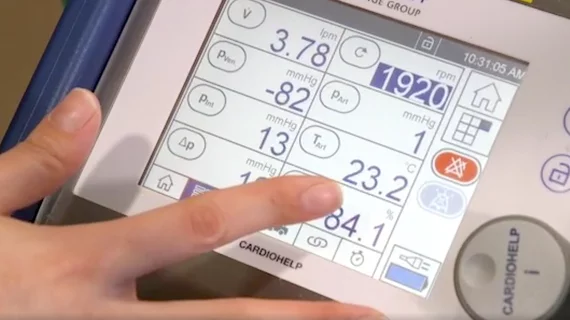Extracorporeal membrane oxygenation (ECMO) can help patients with severe COVID-19 make a successful recovery, according to new data published in the Annals of Thoracic Surgery.[1]
The study’s authors started with a pool of 415 COVID-19 patients who were admitted to the ICU of a single, high-volume facility from March 10 to May 1, 2020. Thirty patients from that group were then chosen to undergo venovenous ECMO (VV-ECMO), a treatment option believed to potentially minimize lung damage compared to conventional mechanical ventilation.
“These patients received ECMO for severe COVID-19 during the height of the pandemic in New York City — at a time when very little was known about the likelihood for success,” lead author Deane E. Smith, MD, a specialist with NYU Langone Health in New York City, said in a prepared statement.
Of the 30 patients treated with ECMO, 28 (93.3%) survived. ECMO treatment lasted for a median of 19 days, and hospitalizations lasted for a median of 45 days. Twenty-seven patients were discharged and able to either go home or to acute rehabilitation. Just one patient required supplemental oxygen.
Smith et al. said patient selection was especially important due to “the number of young, otherwise healthy patients” dying from COVID-19. They chose patients for ECMO treatment based on both the severity of their COVID-related lung damage and their overall chance of survival.
“If there was one theme throughout our experience, it was how we would define success,” Smith said. “We did not feel that using ECMO to have patients survive simply to go to long-term facilities debilitated and vent-dependent was successful, or not as successful as it could be. In other words, we began with the end in mind. If we were going to offer patients ECMO for severe COVID-19, it was because we believed that we could protect the lungs and allow patients to return to their normal lives at the end of it.”
Aggressive patient management was also a key part of the team’s treatment strategy. For example, the team turned to early tracheostomy procedures and frequent bronchoscopy procedures when necessary. Patients were also moved to their abdomens when recovery appeared to be stalling.
Overall, after a median follow-up period of 10.8 months, survival was 86.7%, and patient data were “encouraging.”
“We learned that lung recovery was actually possible,” Smith added. “When the pandemic started, that was not clear.”
Related COVID-19 Content:
Telehealth provided value for heart failure patients during COVID-19 pandemic
Congenital heart disease increases risk of poor COVID-19 outcomes, including death
How COVID-19 vaccination affects the risk of ED visits for cardiac, respiratory issues
New CDC guidance: Waiting longer between COVID-19 vaccine doses could reduce risk of heart damage
Reference:

